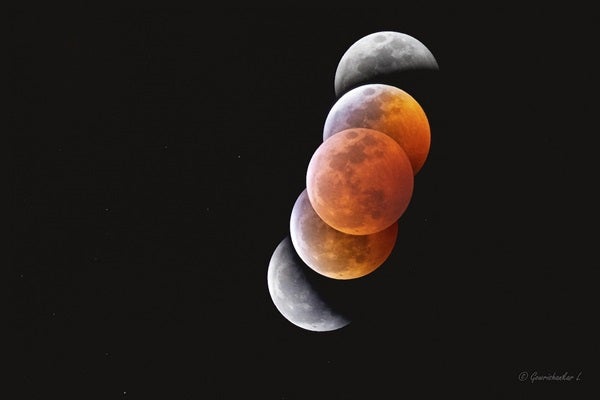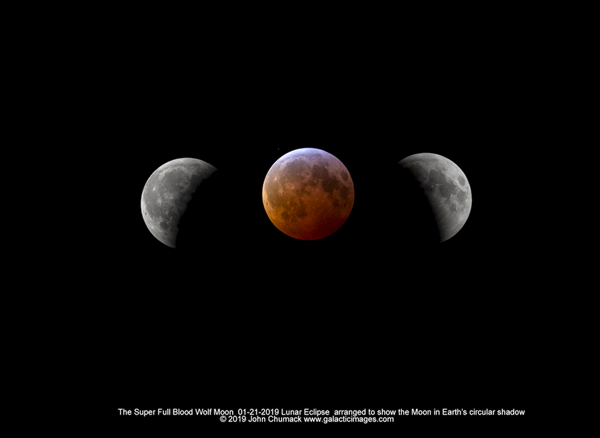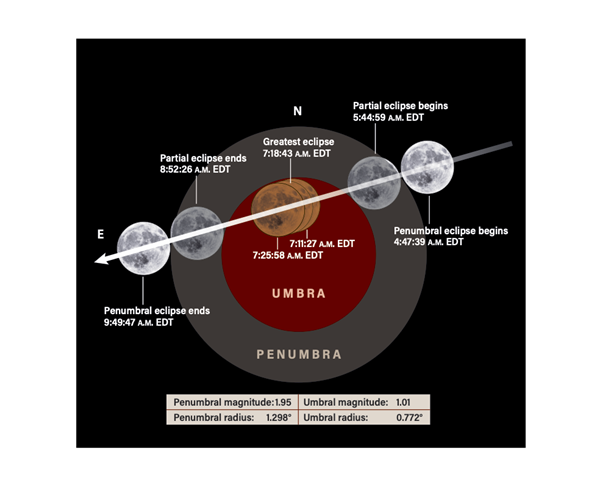A total lunar eclipse generally lasts for hours, requires no equipment to see, and is completely safe to look at — no filter required. There’s no blinding Sun in the sky; all we’re watching is Earth’s shadow fall across Luna’s face. And on the morning of Wednesday, May 26, many observers on our planet’s night side will see that happen.
The most recent total lunar eclipse occurred Jan. 21, 2019. The last one visible in the continental U.S. happened July 27, 2018. Since then, amateur astronomers have been counting the days for the Sun, Earth, and the Moon (in that order) to line up once again.
The only “bad” news is that totality during this eclipse is brief. It lasts a scant 14 minutes 31 seconds. Although that’s short for lunar totality, it’s almost twice as long as the longest solar eclipse totality possible. So, make plans now to view this event. There’s lots of cool stuff to see.
Where and when?
The entire eclipse will be visible throughout Australia, New Zealand, Southeast Asia, Chile, Argentina, and western North America. In the U.S., those who position themselves as far west as possible will have the best views.
The eclipse begins at 4:47:39 a.m. (all times are Eastern Daylight Time), when the Moon enters Earth’s penumbra — its lighter, outer shadow. Our satellite enters the umbra at 5:44:59 a.m., signaling the start of the first partial phase of the eclipse. Totality begins at 7:11:27 a.m. and lasts until 7:25:58 a.m. From there, the event plays itself out in reverse, with the partial phase ending at 8:52:26 a.m. Finally, more than five hours after the Moon first entered Earth’s outer shadow, it fully exits the penumbra at 9:49:47 a.m., officially ending the eclipse.
Totality is so brief during the May 26 eclipse because the Moon doesn’t pass through the center of our planet’s umbra. Instead, Luna’s northern edge passes just inside the umbra’s northern limit. In contrast, its southern edge lies a lot closer to the shadow’s center, so the Moon’s southern half will look much darker than its northern half. Because the Moon crosses a large range of the shadow’s depths throughout totality, the appearance of its face will change significantly as the eclipse progresses.
How dark will it get?
The Moon looks different during the total phase of each eclipse because it takes different paths through Earth’s umbra. The more centered it is, the darker it will get. During this eclipse, therefore, the Moon will definitely look brighter than it would if it passed through the central part of Earth’s shadow. But Luna’s appearance also depends on our atmosphere, which contains water droplets and solid particles like dust and ash, reducing the air’s transparency.
In addition to darkening, the Moon takes on color during totality as Earth’s atmosphere diverts some sunlight into the shadow. The atmosphere also scatters shorter (bluer) wavelengths out of that light, both reddening and darkening the Moon’s face. Lots of clouds along the limb of our planet, as seen from the Moon, can make Luna appear even darker still.
One fun activity is to try to estimate the darkness of a total lunar eclipse. Most observers use a five-point scale developed in 1921 by French astronomer André-Louis Danjon. You can use your naked eyes, binoculars, or a telescope, as long as you make your estimate near the middle of totality.
In Danjon’s system, L values stand for luminosity, or how bright the Moon looks during totality. If L=0, the Moon is almost invisible. When L=1, lunar details will be difficult to distinguish. For L=2, the Moon is deep red or rust colored. L=3 indicates a brick-red Moon, while Earth’s umbral shadow projected on the Moon may have a bright or yellow rim. And if L=4, the Moon looks bright copper-red or orange and the shadow may have a bluish rim.
All ’round the Moon
During this totality, the Northern Hemisphere’s summer constellations will surround the Moon. Throughout the eclipse, the Moon will be in the northern part of Scorpius the Scorpion. That pattern’s brightest star, 1st-magnitude Antares (Alpha [α] Scorpii), will lie 6.5° southeast of the Moon. Antares’ red color will complement the orange Moon, especially through binoculars. (Note: 7×50 binoculars have a 7° field of view.)
No other bright stars are close to the Moon during the eclipse. Spica (Alpha Virginis) stands 41° to its west and Altair (Alpha Aquilae) lies 62° to the northeast. Saturn, at magnitude 0.5, will stand some 70° away in Capricornus, and Jupiter, blazing at magnitude –2.4, will be about 18° farther east in Aquarius.
“Totally” safe
The public is used to hearing the words eclipse and warning together. While that’s valid for solar eclipses, a lunar eclipse poses no danger to your eyes. So, you won’t need a filter and you can magnify the sight with binoculars or a scope.
Because this event occurs early on a Wednesday, people with work or school obligations may choose not to seek it out. The prospects of an eclipse viewing party, therefore, are slim. But consider waking your family 10 minutes before totality starts. Within half an hour, they’ll be back in bed and you’ll have exposed them to some cool, easy-to-understand science. Many astronomy clubs and science centers also plan to host events.
Observing a total lunar eclipse isn’t hard science. It takes little effort and offers a big payback. How long you watch is up to you. You can use optics or not. And you can observe it from the darkest site on Earth or the heart of a city. But however you view this eclipse, have fun!












